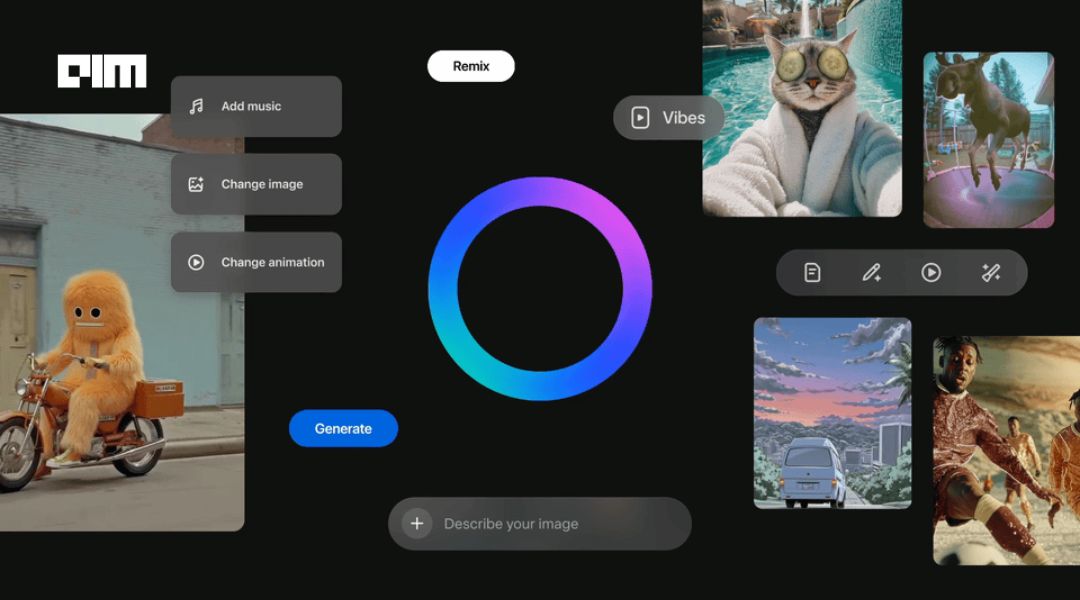Meta has introduced Vibes, a new short‑form video feed hosted within the Meta AI app and via meta.ai, in which every clip is generated or remixed by algorithmic systems. Users can scroll through a continuous stream of AI‑produced videos, or create their own by remixing existing clips, adding visuals, music, style layers, then post to Vibes or cross‑publish to Instagram and Facebook Stories or Reels.
Meta frames Vibes as a way to help users “find creative inspiration and experiment with Meta AI’s media tools.” But critics and users have already begun to push back. In response to Mark Zuckerberg’s Instagram announcement, top comments said: “gang nobody wants this” and “Bro’s posting ai slop on his own app.”
The choice to base a new content surface entirely on synthetic media comes just months after Meta reorganized its AI efforts into a division dubbed Superintelligence Labs. The group now oversees development across research and product teams, with several generative tools already being introduced across Instagram, Facebook, and Messenger.
Between Novelty and User Backlash
It is worth pausing on how Meta has assembled Vibes behind the scenes. According to early disclosures, the initial version leans on partnerships with external image/video generation systems, including Midjourney and Black Forest Labs, while Meta continues developing its own models.
In his announcement on Instagram, Zuckerberg shared sample videos such as a cat kneading dough, fuzzy creatures hopping between cubes, and an Egyptian‑style woman posing for a selfie. That messaging underscored both the creative potential and the risk of uncanny or low‑value content.
User reaction has been swift and mostly negative. One critic on social media remarked: “I think I speak for everyone when I say: What…?” Media commentary has latched on to the phrase “AI slop,” a shorthand for low-effort, often bizarre or generic synthetic media, and some have described Vibes as “an endless stream of AI video junk.”
One way to read the choice is that Meta is leaning into volume and scale rather than editorial curation. Because synthetic media can be produced rapidly and in high supply, Vibes could flood feeds with infinitely many short clips. That may draw eyeballs. But it may also generate fatigue fast. Early coverage paints a tension: what looks novel can also feel empty.
The launch also appears to invert Meta’s earlier messaging. Earlier this year, Meta pushed creators to emphasize “authentic storytelling” over low-value, aggregated video content. Critics see Vibes as contradictory: a platform specifically for synthetic media, potentially at odds with original human expression.
Still, there are practical advantages. Because every clip is born digital, remixing becomes easier. Users can take an existing loop, mutate it, and post it again. That lowers the bar to production for casual users. The built‑in ability to cross-post into Instagram and Facebook means reach is not constrained to a cold new app.
What Vibes Means for the Platform Landscape
Meta is not placing this feature into a silo. It is part of a broader push to monetize generative content and integrate synthetic media deeply into its ecosystem.
As of 2024, Meta reported revenue of nearly US$165 billion. The company is now seeking new surfaces for engagement and ad formats, especially those tied to generative media. Vibes could serve as a testbed: if users scroll, remix, engage, it provides both usage data and fresh inventory for advertising.
The strategy appears aligned with upward pressure on user attention and content supply. Social media platforms are increasingly treating synthetic content not just as a novelty, but as a vector for growth. Vibes is among the first major experiments in populating short-form feeds entirely with AI-originated media.
But there are obvious risks. Flooding feeds with mass-produced synthetic media may erode trust and fatigue users. Synthetic realism can blur boundaries, complicating moderation and fact-checking. As Vibes grows, platform builders will face pressure to distinguish signal from noise, suppress abusive or harmful content, and preserve user trust. Moreover, Vibes could shift incentive structures. If synthetic content outcompetes human-made content in reach, creators may favor generative tools over real craft. That might reshape creator economies, for better or worse.
A study published in Frontiers in Psychology identifies information overload and compulsive use as key drivers of social media fatigue, which can lead to disengagement and decreased trust in platform content. Additionally, content moderation in the era of synthetic media presents new challenges. Research indicates that generative AI complicates the enforcement of platform rules, necessitating a balance between automation and human oversight
Meta’s move is not isolated. TikTok has begun labeling AI-generated videos and experimenting with in-app generative tools, while Snapchat has introduced AI-powered content creation features through its My AI platform. YouTube is testing ways to identify synthetic content in its recommendation system to maintain transparency. The Vibes launch may trigger a new arms race in AI-native content surfaces.










